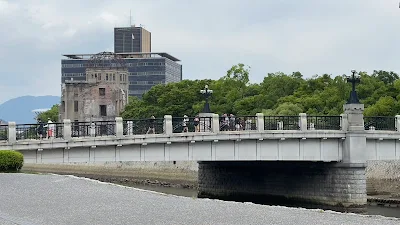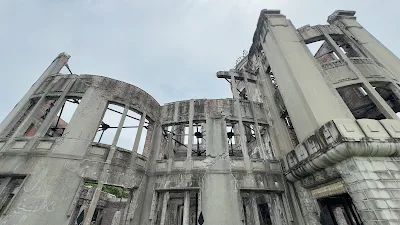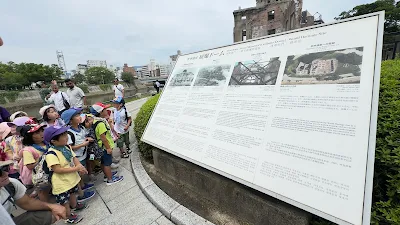 |
| La estación del Tren Bala en Hiroshima: símbolo de una ciudad que decidió avanzar sin olvidar. |
 |
| Desde la distancia, parece una ciudad más. Pero Hiroshima guarda un silencio que grita historia. |
 |
| El Domo: memoria de una explosión que dividió el tiempo en un antes y un después. |
 |
Las ruinas de Hiroshima no son solo restos: son lecciones en piedra, testigos del impacto nuclear. |

Santuario Itsukushima, Miyajima, Japón - Patrimonio de la Humanidad UNESCO
La ciencia nos permite entender el mundo, transformarlo y —a veces— alterarlo de formas irreversibles. Hace un año, visité Hiroshima como turista. Caminé entre ruinas, grullas de papel y monumentos silenciosos. Pero salí de allí como docente, con una convicción más clara que nunca: La ciencia sin ética es peligrosa.

📍 El lugar que marcó un antes y un después
Como educadora en ciencias, no pude evitar preguntarme: ¿Qué rol jugamos quienes enseñamos ciencia en la construcción de un futuro más humano?
💥 Hiroshima no es solo historia: es advertencia
🧪 Educar para la paz, desde la química. Enseñar química es enseñar responsabilidad
Porque detrás de cada fórmula, de cada átomo, de cada reacción, hay decisiones humanas. Como docentes, no solo transmitimos conocimientos: formamos criterio, sembramos dudas, encendemos alertas.
Lo que cambia no es la ciencia. Lo que cambia somos nosotros.
 |
| Estudiantes japoneses recorriendo Hiroshima, julio de 2024. Lecciones al aire libre, donde la historia se enseña con los sentidos. |
👩🏫 Educar para la paz, desde la ciencia
🕊️ Reflexión personal
Hay que enseñar conciencia.
📚 Lo que me llevo de Hiroshima
-
El conocimiento es poder. Pero el poder sin compasión es peligroso.
-
La memoria histórica también es parte del currículo.
-
La paz se construye, también, desde el aula.
-
La ciencia necesita alma, ética y contexto.
✨ A mi comunidad de ProfeQuíMica
Y si alguna vez tienen la oportunidad de visitar Hiroshima, vayan. Escuchen el silencio. Enseña más que mil libros.✨
📷 Fotos:
 |
|
 |
|
🔗 ¿Te interesaría una entrada sobre la ciencia detrás de la energía nuclear? ¿O sobre cómo enseñar ética científica en el aula?
Dejá tu comentario o escribime en Instagram 👉 @profequimica89
Hiroshima and Science: Between Knowledge and Responsibility. Educating for Peace
🚄 The Bullet Train Station in Hiroshima: A symbol of a city that chose to move forward—without forgetting.
🌆 From a distance, it looks like any other city. But Hiroshima holds a silence that screams history.
☢️ The Dome: A memory of an explosion that split time into before and after.
🧱 The ruins of Hiroshima are not just remnants—they are lessons carved in stone, witnesses to nuclear impact.
A year ago, I visited Hiroshima as a tourist. I walked among ruins, paper cranes, and silent monuments.
But I left as a teacher, with a conviction clearer than ever: Science without ethics is dangerous.
📍 The place where everything changed
Hiroshima, Japan: a city that left an indelible mark on world history—and on me.
I stood before the Atomic Bomb Dome, walked through the Peace Memorial Park, and felt a knot in my stomach that still hasn’t gone away.
As a science educator, I couldn’t help but ask myself:
What role do we, as teachers of science, play in building a more humane future?
💥 Hiroshima isn’t just history—it’s a warning
On August 6, 1945, human knowledge reached its most destructive point.
Physics, chemistry, mathematics, and years of research converged into an atomic bomb that, in seconds, wiped out thousands of lives.
The same science that lets us explore the universe can also annihilate cities—if used without conscience.
The bomb dropped on Hiroshima was the result of one of the most impressive—and most devastating—scientific breakthroughs of the 20th century: nuclear fission.
Behind that milestone were theory, calculation, and lab work… but also human decisions.
🧪 Teaching for peace, through chemistry
Teaching chemistry is also teaching responsibility.
Because behind every formula, every atom, every reaction—there are human choices.
As educators, we don’t just pass on knowledge—we shape critical thinking, we plant questions, we sound the alarm.
When I talk about nuclear energy in class, I never forget that the same knowledge was once used for destruction.
But it has also been vital in cancer treatments, medical diagnostics, and the development of clean energy.
It’s not science that changes—it’s us.
👩🏫 Teaching for peace, through science
Standing before the ruined dome made me feel small in the face of what happened—
But also responsible for what could happen if we forget.
Today, more than ever, I believe in a science with soul.
In classrooms where we don’t just memorize reactions, but question, reflect, and humanize knowledge.
🕊️ Personal reflection
In that silence, I thought of my students.
Of how I speak to them about atoms and energy.
Of how science can be a tool to heal… or destroy.
And I felt that teaching chemistry is not enough:
We must teach conscience.
📚 What Hiroshima taught me
Knowledge is power.
But power without compassion is dangerous.
Historical memory must also be part of our curriculum.
Peace is also built in the classroom.
Science needs soul, ethics, and context.
✨ To my ProfeQuíMica community
I invite you to reflect on the role science plays in our society.
May every atom we teach help build a world that’s more just, more aware, more humane.
And if you ever have the chance to visit Hiroshima—go.
Listen to the silence.
It teaches more than a thousand books. ✨
📷 Photos:
-
Peace Museum: An emotional lesson on the human consequences of war.
-
Statue of Sadako and the paper cranes: A symbol of hope, science, and childhood. This monument in Hiroshima moved me deeply.
A silent bust. Two children sitting on stone.
Science is not just knowledge—it’s a choice.
And children are always the ones who inherit those choices. -
View of the Dome: History that has not been forgotten.
🔗 Would you be interested in a post about the science behind nuclear energy? Or about how to teach scientific ethics in the classroom?

Comentarios
Publicar un comentario
Deja tu comentario